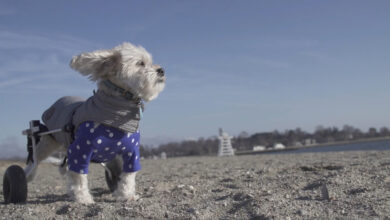Abba Voyage Review: No Ordinary Abba Night at the Club

LONDON — I kept turning to my friend, wanting to tell him how young and fresh the two women that put the As in Abba seemed on the giant screens ahead of us. Agnetha Faltskog and Anni-Frid Lyngstad were not actually in the room with us, but that’s the kind of stupor Abba Voyage dazzles you into.
Though the Swedish pop band has not played London since 1979, holographic “Abbatars” of the band, modeled in their likeness from that year, are currently filling up a custom-built arena for a 90-minute concert of their greatest hits. A combination of motion-captured performance, animated sequences and a live 10-person band make up the spectacle, which makes a floor-thumping case for the music’s continued relevance.
Projected on a screen that envelops one side of the spaceshiplike auditorium, the Abbatars play mostly as if it were a real concert. They “enter” from below the stage, make banter with the audience, ask for patience as they switch costumes, and return for an encore.
It would feel corny if it weren’t so triumphantly fun, and the Friday night crowd was certainly along for the ride. Largely a mix of couples in their mid 60s and younger, disco-leaning gay men, the attendees sang through every number with the intensity of a therapeutic ritual. Abba Voyage is an exercise in symbol worship that separates itself from an ordinary Abba night at the club through state-of-the-art production values.
“To be or not to be — that is no longer the question,” the band member Benny Andersson declares in a prerecorded solo address, and questions about live performance, truth, eternity and transience are frothed up into the sheer giddiness of (almost) being in the same room as one of the biggest acts in pop music history.
It’s hard to pin down the reasons that such a strange, 21st century endeavor is a crowd-pleasing success, but Abba’s music has its own strange alchemy. Take “Mamma Mia” (performed here in rhinestone-emblazoned pink velour jumpsuits): Why is the hook an Italian catchphrase? Or “Fernando” (sung against a dramatic lunar eclipse): What could these four Swedes possibly have to say about the Mexican revolution? And yet, something about the earnestness of those songs, reflected in the audience’s full-chested belting, has made them inescapable pop standards.
Those two songs are performed straightforwardly, the Abbatars life-size and center stage, with surrounding screens projecting close-ups for those seated in the orchestra level, behind a massive dance floor. Most of the numbers are done this way, recreating a concert experience; the audience was overjoyed to dance along and applaud each step of the way. Choreography, based on the band member’s real movements, but captured from younger body doubles, hit its peak during “Gimme! Gimme! Gimme!,” with the digital Lyngstad doing high-kicks and twirls that I’m not sure the real one was capable of in her heyday.
A couple of songs, however, played more like immersive music videos, with the full size of the screens used to tell more thorough visual stories. The band famously sang and performed through its own breakup, and “Knowing Me, Knowing You,” a 1977 anthem mirroring the dissolution of romantic and professional relations in the group, is here performed as an Ingmar Bergman-esque study in missed connections. Its members’ fractured faces sing across a hall of mirrors before ultimately embracing in reconciliation.
Less successful than those episodes were two fully-animated numbers, set to “Eagle” and “Voulez Vous,” following a young traveler’s journey through forests and pyramids, and culminating in their discovery of giant sculptures of the band member’s heads.
Those songs recreate the interstitial bits of a “real” concert, as do speeches from each Abbatar about their success and artistry. The best of these interludes saw the band present the footage from their Eurovision Song Contest-winning performance of “Waterloo,” the song that catapulted them to fame in 1974.
Abba’s music is deceptively complex. What sounds like a simple little song reveals itself to be an intricately layered web of harmonies, melodies, real and digital instruments and angelic English vocals, ever-so-slightly outside the band’s Scandinavian comfort zone.
It’s a mix of wizardry and technical skill that, decades later, after movies and musicals and greatest hits compilations, is still at the pinnacle of pop maximalism. To hear the closing piano riffs on “Chiquitita” in a crowded arena is an exalting experience, and despite its eyebrow-raising premise, Abba Voyage miraculously takes flight.





